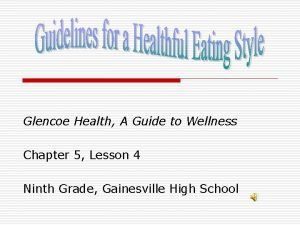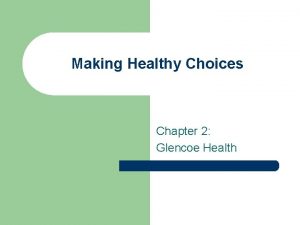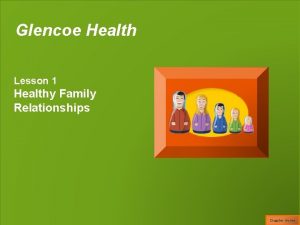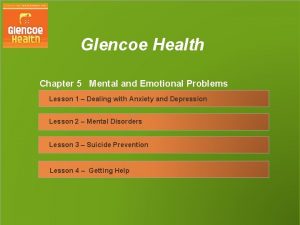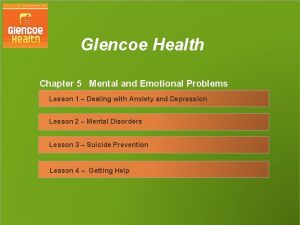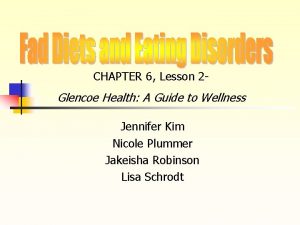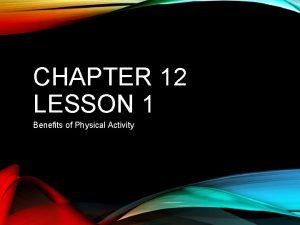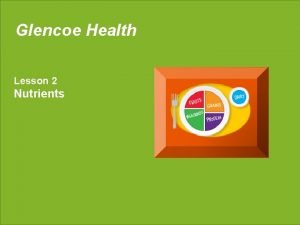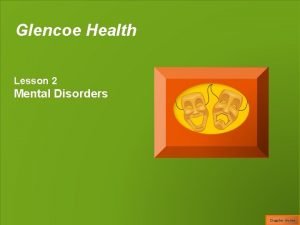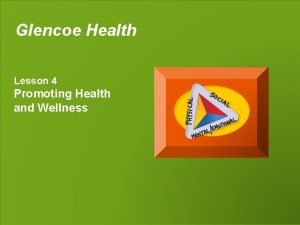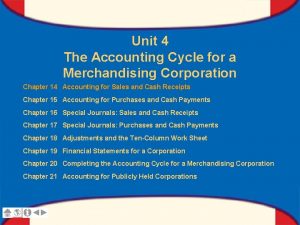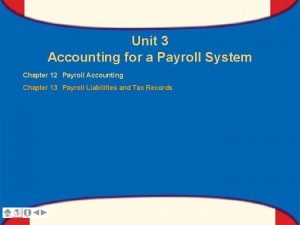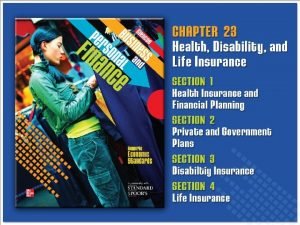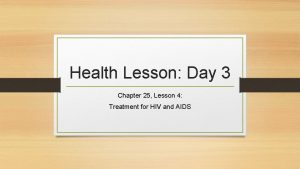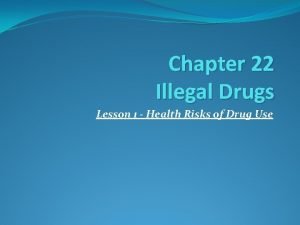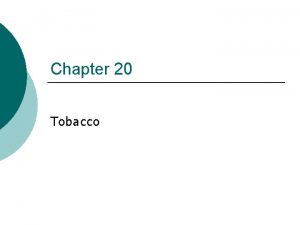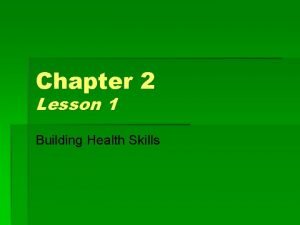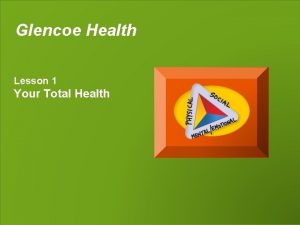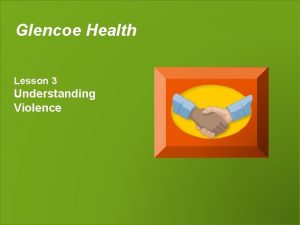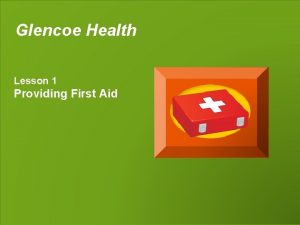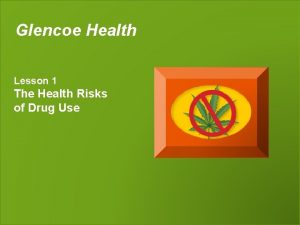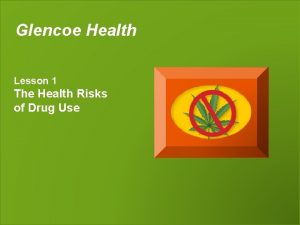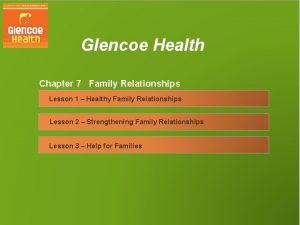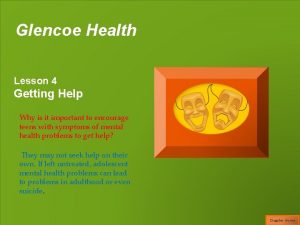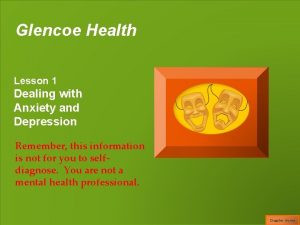CHAPTER 6 Lesson 2 Glencoe Health A Guide



































- Slides: 35

CHAPTER 6, Lesson 2 - Glencoe Health: A Guide to Wellness Jennifer Kim Nicole Plummer Jakeisha Robinson Lisa Schrodt

Presentation

DIET… What does it really mean? n n Probably one of the most hated words in the English language Diet- the usual food and drink of a person or animal.

“Yo-Yo” Dieting n n Individuals go on and off these diets, so their weight fluctuates This cycle of losing, regaining, losing, and regaining weight is known as weight cycling.

Risky Weight-Loss Strategies n Fasting n Avoiding food is dangerous for even a short time- it can deprive you of vital nutrients

Risky Weight-Loss Strategies n Liquid Protein Diets High-protein, low carbohydrate liquid diets can have very serious side effects, even death n U. S. Food and Drug Administration requires a warning label on these products n

Risky Weight-Loss Strategies n Diet Pills Some pills claim to “burn, ” “block, ” or “flush, ” fat from the system. n There are NO low-risk pills that do this n May help control appetite, but can have serious side effects such as drowsiness, anxiety. n

Fad Diets n n n “Approaches to weight control that are popular for a short time, but rarely have any lasting effect. ” What are some common “fad diets? ” *grapefruit diet *cabbage soup diet Let’s see how much you know!

Common Fad Diets n n n Already mentioned the cabbage soup diet and grapefruit diet Atkins diet- cut back on carbohydrates and eat all the meat you want South Beach diet- avoid all highly processed carbohydrates n Hollywood diet- no eating, only drinking

Risks of Fad Diets n n Some fad diets cost a lot of money Most are even more costly to the individual’s health Risks FAR outweigh any benefits Weight loss is usually from water, not body fat

7 Warning Signs of Fad Diets! BEWARE! of any diet or product that: 1. Involves eating only one food 2. Claims that you can eat anything you want or as much as you want 3. Promises quick results 4. Supplies too few calories—below 1, 400 calories a day—for energy and health

7 Warning Signs, continued… 5. Requires a weight loss aid, such as a vitamin pill, a body wrap, liquid shake, appetite suppressant, or the purchase of merchandise 6. Promises spot reducing—weight loss occurs all over, not specific spots! 7. Does not teach a person how to make lifestyle changes to achieve permanent weight loss

Did You Know…? n The average female fashion model is about 5’ 8” and weighs less than 110 pounds n Many young women compare themselves to these unrealistic body images and it contributes to eating disorders.

Eating Disorders n n There are 2 main eating disorders Research has shown that about 1% of US teens have an eating disorder

Anorexia Nervosa n “A disorder in which the irrational fear of becoming obese results in severe weight loss from self-induced starvation. ” Anorexia= without appetite n Nervosa=of nervous origin n

Anorexia Nervosa n Psychological disorder with emotional and physical consequences n Self-concept plays a huge role in whether one person is more susceptible than another for an eating disorder.

Signs of Anorexia Nervosa n The following behaviors are typical: Extremely low caloric intake n Obsession with exercising n Emotional distress n Unnatural interest in food n Distorted body image n Denial of an eating problem* n

Signs of Anorexia Nervosa n Physical symptoms of anorexia Extreme weight loss n Constipation n Hormonal changes n Heart damage n BMI (body mass index) 30% below normal. n See graph next page n

Body Mass Index Graph Remember our model? 5’ 8” and 110 pounds… How healthy is she?

Physical Symptoms continued… Impaired immune function n Decreased heart rate n Cessation of menstrual cycle in females n n Death

Who’s Most at Risk? n n Females 13 -15 and 17 -18 Women and men in “appearance” sports: dancing, gymnastics, track, wrestling, etc. Men and women in the military Vegetarians

Re-Cap: Anorexia n n n At least 15% to 60% of normal body weight is lost Individuals with anorexia have an intense fear of gaining weight Obsessive compulsive behavior, excessive exercising, depression, and talking about food and their weight all the time are significant indicators of anorexia

Bulimia Nervosa n n n “A disorder in which cycles of overeating are followed by some form of purging” Bulimia= excessive or insatiable appetite Nervosa= of nervous origin

Bulimia n n A person with bulimia follows a restrictive diet then binges--quickly eats large quantities of food--when hungry This behavior is followed by selfinduced vomiting or purging through abuse of laxatives

Bulimia n n After a binge, a person may try to follow a severely restrictive diet* Vomiting or purging becomes a daily routine

Side effects of Bulimia n n Dehydration (from vomiting and diarrhea) Kidney damage Irregular heartbeat Erosion of tooth enamel, tooth decay, damage to tissues of stomach, esophagus, and mouth

Side effects of Bulimia n n Laxative abuse interferes with digestion and absorption Nutrient deficiencies Serious damage of blood composition Death

Did you know? n n Though secretive, bulimics often know they have a problem. Bulimics often look like they’re at a normal weight, so it could be anyone…your neighbor boyfriend, girl friend, etc.

Did you know? n n n Bingeing 2 times or more a week for 6 months classifies a person as bulimic, although once a week is usually enough. Eating 5, 000 -15, 000 calories in one sitting is considered a binge Time to test your knowledge!

How can you help? n If you have a friend with an eating disorder, follow these tips: 1. 2. 3. Listen Use active listening skills and encourage your friend to share feelings honestly Help your friend find an adult or professional help.

Where to get help… n n It is helpful to go to an adult, whether it’s the school nurse, a counselor, your parents, or your friends parents However, if you have no idea where to go or what to do you can call these national hotlines for eating disorders:

Hotline Numbers n National Eating Disorders Association: 1 -800 -931 -2237 n National Eating Disorders Association n n National Eating Disorder Referral and Information Center: n 858 -481 -1515

Remember! n n You cannot force someone to change, but anorexia and bulimia are very serious disorders. If someone confides in you, you need to tell an adult so they can get help. THEY CAN DIE FROM THIS!

Remember! n n n Anorexia Nervosa and Bulimia Nervosa are not diseases; they are symptoms of other problems This makes them psychological disorders People with these disorders need medical and professional help—DO NOT try and counsel a friend on your own!

THANK YOU!!!!
 Chapter 1 lesson 2 what affects your health
Chapter 1 lesson 2 what affects your health Chapter 1 lesson 1 your total health
Chapter 1 lesson 1 your total health Achieving mental and emotional health
Achieving mental and emotional health Chapter 5 glencoe health
Chapter 5 glencoe health Glencoe health chapter 2
Glencoe health chapter 2 Chapter 19 vocabulary glencoe health
Chapter 19 vocabulary glencoe health Glencoe health chapter 7
Glencoe health chapter 7 Chapter 5 mental and emotional problems
Chapter 5 mental and emotional problems Glencoe health chapter 5
Glencoe health chapter 5 Chapter 5 lesson 3 suicide prevention
Chapter 5 lesson 3 suicide prevention Chapter 6 glencoe health
Chapter 6 glencoe health Chapter 12 lesson 3 planning a personal activity program
Chapter 12 lesson 3 planning a personal activity program Chapter 12 physical activity and fitness
Chapter 12 physical activity and fitness Texture repair glencoe
Texture repair glencoe Glencoe health chapter 2 review answers
Glencoe health chapter 2 review answers Chapter 1 lesson 4 promoting health and wellness
Chapter 1 lesson 4 promoting health and wellness Overall state of well being or total health
Overall state of well being or total health Glencoe accounting chapter 14 answer key
Glencoe accounting chapter 14 answer key Glencoe accounting chapter 13 answer key
Glencoe accounting chapter 13 answer key Physics chapter 2 review
Physics chapter 2 review Glencoe sustainability task force
Glencoe sustainability task force Copyright glencoe/mcgraw-hill answer key
Copyright glencoe/mcgraw-hill answer key Glencoe the developing child
Glencoe the developing child Periodic table glencoe
Periodic table glencoe Glencoe personal finance
Glencoe personal finance Glencoe exploring careers
Glencoe exploring careers Chapter 1 lesson 5 angle relationships
Chapter 1 lesson 5 angle relationships Glencoe exploring careers
Glencoe exploring careers Glencoe business and personal finance
Glencoe business and personal finance Chapter 3 health wellness and health disparities
Chapter 3 health wellness and health disparities Chapter 25 lesson 2 health
Chapter 25 lesson 2 health Chapter 22 lesson 1
Chapter 22 lesson 1 Chapter 20 lesson 1 the health risks of tobacco use
Chapter 20 lesson 1 the health risks of tobacco use Chapter 1 lesson 1 your total health
Chapter 1 lesson 1 your total health Chapter 10 nutrition for health lesson 2 answer key
Chapter 10 nutrition for health lesson 2 answer key Lesson 4 promoting health and wellness
Lesson 4 promoting health and wellness



